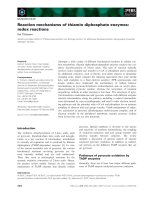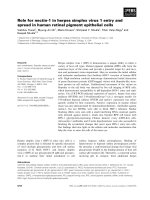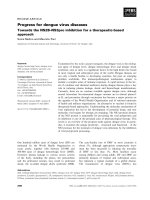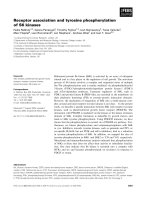Tài liệu Báo cáo khoa học: "Co-training for Predicting Emotions with Spoken Dialogue Data" pdf
Bạn đang xem bản rút gọn của tài liệu. Xem và tải ngay bản đầy đủ của tài liệu tại đây (109.86 KB, 4 trang )
Co-training for Predicting Emotions with Spoken Dialogue Data
Beatriz Maeireizo and Diane Litman and Rebecca Hwa
Department of Computer Science
University of Pittsburgh
Pittsburgh, PA 15260, U.S.A.
, ,
Abstract
Natural Language Processing applications
often require large amounts of annotated
training data, which are expensive to obtain.
In this paper we investigate the applicability of
Co-training to train classifiers that predict
emotions in spoken dialogues. In order to do
so, we have first applied the wrapper approach
with Forward Selection and Naïve Bayes, to
reduce the dimensionality of our feature set.
Our results show that Co-training can be
highly effective when a good set of features
are chosen.
1 Introduction
In this paper we investigate the automatic
labeling of spoken dialogue data, in order to train a
classifier that predicts students’ emotional states in
a human-human speech-based tutoring corpus.
Supervised training of classifiers requires
annotated data, which demands costly efforts from
human annotators. One approach to minimize this
effort is to use Co-training (Blum and Mitchell,
1998), a semi-supervised algorithm in which two
learners are iteratively combining their outputs to
increase the training set used to re-train each other
and generate more labeled data automatically. The
main focus of this paper is to explore how Co-
training can be applied to annotate spoken
dialogues. A major challenge to address is in
reducing the dimensionality of the many features
available to the learners.
The motivation for our research arises from the
need to annotate a human-human speech corpus for
the ITSPOKE (Intelligent Tutoring SPOKEn
dialogue System) project (Litman and Silliman,
2004). Ongoing research in ITSPOKE aims to
recognize emotional states of students in order to
build a spoken dialogue tutoring system that
automatically predicts and adapts to the student’s
emotions. ITSPOKE uses supervised learning to
predict emotions with spoken dialogue data. Al-
though a large set of dialogues have been
collected, only 8% of them have been annotated
(10 dialogues with a total of 350 utterances), due to
the laborious annotation process. We believe that
increasing the size of the training set with more
annotated examples will increase the accuracy of
the system’s predictions. Therefore, we are
looking for a less labour-intensive approach to data
annotation.
2 Data
Our data consists of the student turns in a set of
10 spoken dialogues randomly selected from a
corpus of 128 qualitative physics tutoring
dialogues between a human tutor and University of
Pittsburgh undergraduates. Prior to our study, the
453 student turns in these 10 dialogues were
manually labeled by two annotators as either
"Emotional" or "Non-Emotional" (Litman and
Forbes-Riley, 2004). Perceived student emotions
(e.g. confidence, confusion, boredom, irritation,
etc.) were coded based on both what the student
said and how he or she said it. For this study, we
use only the 350 turns where both annotators
agreed on the emotion label. 51.71% of these turns
were labeled as Non-Emotional and the rest as
Emotional.
Also prior to our study, each annotated turn was
represented as a vector of 449 features
hypothesized to be relevant for emotion prediction
(Forbes-Riley and Litman, 2004). The features
represent acoustic-prosodic (pitch, amplitude,
temporal), lexical, and other linguistic
characteristics of both the turn and its local and
global dialogue context.
3 Machine Learning Techniques
In this section, we will briefly describe the ma-
chine learning techniques used by our system.
3.1 Co-training
To address the challenge of training classifiers
when only a small set of labeled examples is
available, Blum and Mitchell (1998) proposed Co-
training as a way to bootstrap classifiers from a
large set of unlabeled data. Under this framework,
two (or more) learners are trained iteratively in
tandem. In each iteration, the learners classify
more unlabeled data to increase the training data
for each other. In theory, the learners must have
distinct views of the data (i.e., their features are
conditionally independent given the label
example), but some studies suggest that Co-
training can still be helpful even when the
independence assumption does not hold (Goldman,
2000).
To apply Co-training to our task, we develop
two high-precision learners: Emotional and Non-
Emotional. The learners use different features
because each is maximizing the precision of its
label (possibly with low recall). While we have
not proved these two learners are conditionally
independent, this division of expertise ensures that
the learners are different. The algorithm for our
Co-training system is shown in Figure 1. Each
learner selects the examples whose predicted
labeled corresponds to its expertise class with the
highest confidence. The maximum number of
iterations and the number of examples added per
iteration are parameters of the system.
While iteration < MAXITERATION
Emo_Learner.Train(train)
NE_Learner.Train(train)
emo_Predictions = Emo_Learner.Predict(predict)
ne_Predictions = NE_Learner.Predict(predict)
emo_sorted_Predictions = Sort_by_confidence(
emo_Predictions)
ne_sorted_Predictions = Sort_by_confidence(
ne_Predictions)
best_emo = Emo_Learner.select_best(
emo_sorted_Predictions,
NUM_SAMPLES_TO_ADD)
best_ne = NE_Learner.select_best(
ne_sorted_Predictions,
NUM_SAMPLES_TO_ADD)
train = train ∪ best_emo ∪ best_ne
predict = predict – best_emo – best_ne
end
Figure 1. Algorithm for Co-training System
3.2 Wrapper Approach with Forward
Selection
As described in Section 2, 449 features have
been currently extracted from each utterance of the
ITSPOKE corpus (where an utterance is a
student’s turn in a dialogue). Unfortunately, high
dimensionality, i.e. large amount of input features,
may lead to a large variance of estimates, noise,
overfitting, and in general, higher complexity and
inefficiencies in the learners. Different approaches
have been proposed to address this problem. In
this work, we have used the Wrapper Approach
with Forward Selection.
The Wrapper Approach, introduced by John et
al. (1994) and refined later by Kohavi and John
(1997), is a method that searches for a good subset
of relevant features using an induction algorithm as
part of the evaluation function. We can apply
different search algorithms to find this set of
features.
Forward Selection is a greedy search algorithm
that begins with an empty set of features, and
greedily adds features to the set. Figure 2 shows
our algorithm implemented for the forward
wrapper approach.
bestFeatures = []
while dim(bestFeatures) < MINFEATURES
for iterations = 1: MAXITERATIONS
split train into training/development
parameters = computeParameters(training)
for feature = 1:MAXFEATURES
evaluate(parameters,development,
[bestFeatures + feature])
keep validation performance
end
end
average_performance and keep average_performance
end
B = best average_performance
bestFeatures B ∪ bestFeatures
end
Figure 2. Implemented algorithm for forward
wrapper approach. The variables underlined are
the ones whose parameters we have changed in
order to test and improve the performance.
We can use different criteria to select the feature
to add, depending on the object of optimization.
Earlier, we have explained the basis of the Co-
training system. When developing an expert
learner in one class, we want it to be correct most
of the time when it guesses that class. That is, we
want the classifier to have high precision (possibly
at the cost of lower overall accuracy). Therefore,
we are interested in finding the best set of features
for precision in each class. In this case, we are
focusing on Emotional and Non-Emotional
classifiers.
Figure 3 shows the formulas used for the
optimization criterion on each class. For the
Emotional Class, our optimization criterion was to
maximize the PPV (Positive Predictive Value), and
for the Non-Emotional Class our optimization
criterion was to maximize the NPV (Negative
Predictive Value).
Figure 3. Confusion Matrix, Positive Predictive
Value (Precision for Emotional) and Negative
Predictive Value (Precision for Non-Emotional)
4 Experiments
For the following experiments, we fixed the size
of our training set to 175 examples (50%), and the
size of our test set to 140 examples (40%). The
remaining 10% has been saved for later
experiments.
4.1 Selecting the features
The first task was to reduce the dimensionality
and find the best set of features for maximizing the
PPV for Emotional class and NPV for Non-
Emotional class. We applied the Wrapper
Approach with Forward Selection as described in
section 3.2, using Naïve Bayes to evaluate each
subset of features.
We have used 175 examples for the training set
(used to select the best features) and 140 for the
test set (used to measure the performance). The
training set is randomly divided into two sets in
each iteration of the algorithm: One for training
and the other for development (65% and 35%
respectively). We train the learners with the
training set and we evaluate the performance to
pick the best feature with the development set.
Number of
Features
Naïve
Bayes
AdaBoost-j48
Decision Trees
All Features 74.5 %
83.1 %
3 best for PPV 92.9 %
92.9 %
Table 1. Precision of Emotional with all features
and 3 best features for PPV using Naïve Bayes
(used for Feature Selection) and AdaBoost-j48
Decision Trees (used for Co-training)
The selected features that gave the best PPV for
Emotional Class are 2 lexical features and one
acoustic-prosodic feature. By using them we
increased the precision of Naïve Bayes from 74.5%
(using all 449 features) to 92.9%, and of
AdaBoost-j48 Decision Trees from 83.1% to
92.9% (see Table 1).
Number of
Features
Naïve
Bayes
AdaBoost-j48
Decision Trees
All Features 74.2 %
90.7 %
1 best for NPV
100.0 %
100.0 %
Table 2. Precision of Non-Emotional with all
features and best feature for NPV using Naïve
Bayes (used for Feature Selection) and AdaBoost-
j48 Decision Trees (used for Co-training)
For the Non-Emotional Class, we increased the
NPV of Naïve Bayes from 74.2% (with all
features) to 100% just by using one lexical feature,
and the NPV of AdaBoost-j48 Decision Trees from
90.7% to 100%. This precision remained the same
with the set of 3 best features, one lexical and two
non-acoustic prosodic features (see Table 2).
These two set of features for each learner are
disjoint.
4.2 Co-training experiments
The two learners are initialized with only 6
labeled examples in the training set. The Co-
training system added examples from the 140
“pseudo-labeled” examples
1
in the Prediction Set.
The size of the training set increased in each
iteration by adding the 2 best examples (those with
the highest confidence scores) labeled by the two
learners. The Emotional learner and the Non-
Emotional learner were set to work with the set of
features selected by the wrapper approach to
optimize the precision (PPV and NPV) as
described in section 4.1.
We have applied Weka’s (Witten and Frank,
2000) AdaBoost’s version of j48 decision trees (as
used in Forbes-Riley and Litman, 2004) to the 140
unseen examples of the test set for generating the
learning curve shown in figure 4.
Figure 4 illustrates the learning curve of the
accuracy on the test set, taking the union of the set
of features selected to label the examples. We
used the 3 best features for PPV for the Emotional
Learner and the best feature for NPV for the Non-
Emotional Learner (see Section 4.1). The x-axis
shows the number of training examples added; the
y-axis shows the accuracy of the classifier on test
instances. We compare the learning curve from
Co-training with a baseline of majority class and
an upper-bound, in which the classifiers are trained
on human-annotated data. Post-hoc analyses
reveal that four incorrectly labeled examples were
added to the training set: example numbers 21, 22,
45, and 51 (see the x-axis). Shortly after the
inclusion of example 21, the Co-training learning
curve diverges from the upper-bound. All of them
correspond to Non-Emotional examples that were
labeled as Emotional by the Emotional learner with
the highest confidence.
The Co-training system stopped after adding 58
examples to the initial 6 in the training set because
the remaining data cannot be labeled by the
learners with high precision. However, as we can
see, the training set generated by the Co-training
technique can perform almost as well as the upper-
bound, even if incorrectly labeled examples are
included in the training set.
1
This means that although the example has been
labeled, the label remains unseen to the learners.
Learning Curve - Accuracy (features for Emotional/Non-Emotional Precision)
0
0.1
0.2
0.3
0.4
0.5
0.6
0.7
0.8
0.9
1
1 7 13 19 25 31 37 43 49 55 61 67 73 79 85 91 97 103 109 115 121 127 133 139 145 151 157 163 169 175
Majority Class Cotrain Upper-bound
Figure 4. Learning Curve of Accuracy using best features for Precision of Emotional/Non-Emotional
5 Conclusion
We have shown Co-training to be a promising
approach for predicting emotions with spoken
dialogue data. We have given an algorithm that
increased the size of the training set producing
even better accuracy than the manually labeled
training set, until it fell behind due to its inability
to add more than 58 examples.
We have shown the positive effect of selecting
a good set of features optimizing precision for
each learner and we have shown that the features
can be identified with the Wrapper Approach.
In the future, we will verify the generalization
of our results to other partitions of our data. We
will also try to address the limitation of noise in
our Co-training System, and generalize our
solution to a corresponding corpus of human-
computer data (Litman and Forbes-Riley, 2004).
We will also conduct experiments comparing Co-
training with other semi-supervised approaches
such as self-training and Active learning.
6 Acknowledgements
Thanks to R. Pelikan, T. Singliar and M.
Hauskrecht for their contribution with Feature
Selection, and to the NLP group at University of
Pittsburgh for their helpful comments. This
research is partially supported by NSF Grant No.
0328431.
References
A. Blum and T. Mitchell. 1998. Combining
Labeled and Unlabeled Data with Co-training.
Proceedings of the 11
th
Annual Conference on
Computational Learning Theory: 92-100.
K. Forbes-Riley and D. Litman. 2004. Predicting
Emotion in Spoken Dialogue from Multiple
Knowledge Sources. Proceedings of Human
Language Technology Conference of the North
American Chapter of the Association for
Computational Linguistics (HLT/NAACL).
S. Goldman and Y. Zhou. 2000. Enhancing
Supervised Learning with Unlabeled Data.
International Joint Conference on Machine
Learning, 2000.
G. H. John, R. Kohavi and K. Pleger. 1994.
Irrelevant Features and the Subset Selection
Problem. Machine Learning: Proceedings of
11
th
International Conference:121-129, Morgan
Kaufmann Publishers, San Francisco, CA.
R. Kohavi and G. H. John. 1997. Wrappers for
Feature Subset Selection. Artificial
Intelligence, Volume 97, Issue 1-2.
D. J. Litman and K. Forbes-Riley, 2004.
Annotating Student Emotional States in Spoken
Tutoring Dialogues. Proc. 5th Special Interest
Group on Discourse and Dialogue Workshop
on Discourse and Dialogue (SIGdial).
D. J. Litman and S. Silliman, 2004. ITSPOKE: An
Intelligent Tutoring Spoken Dialogue System.
Companion Proceedings of Human Language
Technology conf. of the North American
Chapter of the Association for Computational
Linguistics (HLT/NAACL).
I. H. Witten and E. Frank. 2000. Data Mining:
Practical Machine Learning Tools and
Techniques with Java implementations. Morgan
Kaufmann, San Francisco.









